Textile-Integrated Thermocouples for Temperature Measurement
Abstract
1. Introduction
- Textile thermocouples detect changes in temperature and consist of an indispensable conductive textile matrix with a textile character.
2. Concepts of Thermocouple Construction in Textiles
3. Other Strategies for Temperature Measurement in Textiles
4. Aspects of Manufacturing
4.1. Integration of Electrically Conductive Elements
4.2. Aspects of Aging
4.3. Aspects of Life Cycle of Conductive Textiles and their Regulation
5. Temperature Sensors and E-Textiles
5.1. Wearable Heaters
5.2. Sensor Integration in Textiles
5.3. Body Sweat/Moisture and Heat Transfer in Textiles
6. Outlook and Future Perspectives
Author Contributions
Funding
Conflicts of Interest
References
- Bonauto, D.; Anderson, R.; Rauser, E.; Burke, B. Occupational heat illness in Washington State, 1995–2005. Am. J. Ind. Med. 2007, 50, 940–950. [Google Scholar] [CrossRef]
- Donoghue, A.M. Heat illness in the U.S. mining industry. Am. J. Ind. Med. 2004, 45, 351–356. [Google Scholar] [CrossRef] [PubMed]
- Howe, A.S.; Boden, B.P. Heat-Related Illness in Athletes. Am. J. Sports Med. 2007, 35, 1384–1395. [Google Scholar] [CrossRef] [PubMed]
- Xu, X.; Karis, A.J.; Buller, M.J.; Santee, W.R. Relationship between core temperature, skin temperature, and heat flux during exercise in heat. Graefe’s Arch. Clin. Exp. Ophthalmol. 2013, 113, 2381–2389. [Google Scholar] [CrossRef] [PubMed]
- Niedermann, R.; Psikuta, A.; Rossi, R.M. Heat flux measurements for use in physiological and clothing research. Int. J. Biometeorol. 2014, 58, 1069–1075. [Google Scholar] [CrossRef] [PubMed]
- Leonov, V. Thermoelectric Energy Harvesting of Human Body Heat for Wearable Sensors. IEEE Sensors J. 2013, 13, 2284–2291. [Google Scholar] [CrossRef]
- Morozumi, Y.; Akaki, K.; Tanabe, N. Heat and moisture transfer in gaps between sweating imitation skin and nonwoven cloth: effect of gap space and alignment of skin and clothing on the moisture transfer. Heat Mass Transf. 2012, 48, 1235–1245. [Google Scholar] [CrossRef]
- Gibson, P.; Charmchi, M. Coupled Heat and Mass Transfer Though Hygroscopic Porous Materials—Application to Clothing Layers. Sen’I Gakkaishi 1997, 53, 183–194. [Google Scholar] [CrossRef]
- Dias, T. Electronic Textiles: Smart Fabrics and Wearable Technology, 1st ed.; Dias, T., Ed.; Woodhead: Oxford, UK, 2015; ISBN 9780081002018. [Google Scholar]
- Li, H.; Yang, H.; Li, E.; Liu, Z.; Wei, K. Wearable sensors in intelligent clothing for measuring human body temperature based on optical fiber Bragg grating. Opt. Express 2012, 20, 11740–11752. [Google Scholar] [CrossRef]
- Michalski, L.; Eckersdorf, K.; Kucharski, J.; McGhee, J. Temperature Measurement, 2nd ed.; John Wiley & Sons LTD: West Sussex, UK, 2001; ISBN 0521433630. [Google Scholar]
- Lee, H.S. Thermal Design: Heat Sinks, Thermoelectrics, Heat Pipes, Compact Heat Exchangers, and Solar Cells; John Wiley & Sons: Hoboken, NJ, USA, 2010; ISBN 9780470496626. [Google Scholar]
- Nicholas, J.V.; White, D.R. Traceable Temperatures, 2nd ed.; Wiley: West Sussex, UK, 2001; ISBN 0471492914. [Google Scholar]
- Göpel, W.; Hesse, J.; Zemel, J.N. Thermal Sensors; VCH: Weinheim, Germany, 1990; Volume 4, ISBN 3527267700. [Google Scholar]
- Senturia, D.S.; Wedlock, D.B. Electronic Circuits and Applications; Wiley Inte.; John Wiley & Sons, Inc.: New York, NY, USA, 1975; ISBN 0-471-77631-9. [Google Scholar]
- McCall, C.I. US 3284247 1966, 1–3. Espacene. Available online: https://worldwide.espacenet.com/patent/search/family/023136070/publication/US3284247A?q=pn%3DUS3284247A (accessed on 2 December 2019).
- Daily, N.J.; Poteet, F.R.; Rahn, W.M.; Welch, D.L. US 6550963B2 2003. Espacenet. Available online: https://worldwide.espacenet.com/patent/search/family/025288530/publication/US2003016730A1?q=US%206550963B2 (accessed on 12 December 2019).
- Usher, J.D.; Blaze, J.E.; Phillippi, M.R. US 5071258 1991. Espacenet. Available online: https://worldwide.espacenet.com/patent/search/family/024605372/publication/US5071258A?q=US%205071258%20 (accessed on 2 December 2019).
- Smith, E.T.; Cooper, L.C. US 20050257822A1 2005. Espacenet. Available online: https://worldwide.espacenet.com/patent/search/family/034970526/publication/US2005257822A1?q=US2005257822 (accessed on 1 December 2019).
- Liu, H.; Sun, W.; Xu, S. An Extremely Simple Thermocouple Made of a Single Layer of Metal. Adv. Mater. 2012, 24, 3275–3279. [Google Scholar] [CrossRef]
- Sun, W.; Liu, H.; Gong, W.; Peng, L.-M.; Xu, S.-Y. Unexpected size effect in the thermopower of thin-film stripes. J. Appl. Phys. 2011, 110, 83709. [Google Scholar] [CrossRef]
- Basko, D.; Basko, D. A Photothermoelectric Effect in Graphene. Appl. Phys. 2011, 334, 610–611. [Google Scholar] [CrossRef] [PubMed]
- Seeberg, T.M.; Røyset, A.; Jahren, S.; Strisland, F. Printed organic conductive polymers thermocouples in textile and smart clothing applications. In Proceedings of the 2011 Annual International Conference of the IEEE Engineering in Medicine and Biology Society, Boston, MA, USA, 30 August–3 September 2011; pp. 3278–3281. [Google Scholar]
- Depla, D.; Segers, S.; Leroy, W.; Van Hove, T.; Van Parys, M. Smart textiles: an explorative study of the use of magnetron sputter deposition. Text. Res. J. 2011, 81, 1808–1817. [Google Scholar] [CrossRef]
- Mrugala, D.; Ziegler, F.; Kostelnik, J.; Lang, W. Temperature Sensor Measurement System for Firefighter Gloves. Procedia Eng. 2012, 47, 611–614. [Google Scholar] [CrossRef][Green Version]
- Ziegler, S.; Frydrysiak, M. Initial research into the structure and working conditions of textile thermocouples. Fibres Text. East. Eur. 2009, 77, 84–88. [Google Scholar]
- Takatera, M.; Uchiyama, E.; Zhu, C.; Kim, K.; Ishizawa, H. Effect of air gap on apparent temperature of body wearing various sizes of T-shirt. IOP Conf. Series: Mater. Sci. Eng. 2017, 254, 182012. [Google Scholar] [CrossRef]
- Gidik, H.; Bedek, G.; Dupont, D.; Codau, C. Impact of the textile substrate on the heat transfer of a textile heat flux sensor. Sensors Actuators A: Phys. 2015, 230, 25–32. [Google Scholar] [CrossRef]
- Zhu, C.; Takatera, M. A new thermocouple technique for the precise measurement of in-plane capillary water flow within fabrics. Text. Res. J. 2014, 84, 513–526. [Google Scholar] [CrossRef]
- Ataman, C.; Kinkeldei, T.; Quintero, A.V.; Molina-Lopez, F.; Courbat, J.; Cherenack, K.; Briand, D.; Troster, G.; De Rooij, N. Humidity and Temperature Sensors on Plastic Foil for Textile Integration. Procedia Eng. 2011, 25, 136–139. [Google Scholar] [CrossRef]
- Johnsen, D.L.; Rood, M.J. Temperature Control during Regeneration of Activated Carbon Fiber Cloth with Resistance-Feedback. Environ. Sci. Technol. 2012, 46, 11305–11312. [Google Scholar] [CrossRef]
- Bielska, S.; Sibiński, M.; Lukasik, A. Polymer temperature sensor for textronic applications. Mater. Sci. Eng. B 2009, 165, 50–52. [Google Scholar] [CrossRef]
- Roh, J.S.; Kim, S. All-fabric intelligent temperature regulation system for smart clothing applications. J. Intell. Mater. Syst. Struct. 2016, 27, 1165–1175. [Google Scholar] [CrossRef]
- Sibiński, M.; Jakubowska, M.; Sloma, M. Flexible Temperature Sensors on Fibers. Sensors 2010, 10, 7934–7946. [Google Scholar] [CrossRef] [PubMed]
- Pola, T.; Vanhala, J. Resistance Measurements in Conductive Fabrics. Adv. Mater. Res. 2011, 213, 121–125. [Google Scholar] [CrossRef]
- Hughes-Riley, T.; Lugoda, P.; Dias, T.; Trabi, C.L.; Morris, R.H. A Study of Thermistor Performance within a Textile Structure. Sensors 2017, 17, 1804. [Google Scholar] [CrossRef] [PubMed]
- Kinkeldei, T.; Zysset, C.; Cherenack, K.; Troster, G. A textile integrated sensor system for monitoring humidity and temperature. In Proceedings of the 2011 16th International Solid-State Sensors, Actuators and Microsystems Conference, Beijing, China, 5–9 June 2011; Institute of Electrical and Electronics Engineers (IEEE): Piscataway Township, NZ, USA, 2011; pp. 1156–1159. [Google Scholar]
- Blasdel, N.J.; Wujcik, E.K.; Carletta, J.E.; Lee, K.S.; Monty, C.N. Fabric nanocomposite resistance temperature detector. IEEE Sens. J. 2015, 15, 300–306. [Google Scholar] [CrossRef]
- Kinkeldei, T.; Zysset, C.; Cherenack, K.; Troester, G. Development and evaluation of temperature sensors for textile integration. In Proceedings of the 2009 IEEE Sensors, Christchurch, New Zealand, 25–28 October 2009; pp. 1580–1583. [Google Scholar]
- Husain, M.D.; Kennon, R.; Dias, T. Design and fabrication of Temperature Sensing Fabric. J. Ind. Text. 2014, 44, 398–417. [Google Scholar] [CrossRef]
- Zhao, X.; Long, Y.; Yang, T.; Li, J.; Zhu, H. Simultaneous High Sensitivity Sensing of Temperature and Humidity with Graphene Woven Fabrics. ACS Appl. Mater. Interfaces 2017, 9, 30171–30176. [Google Scholar] [CrossRef]
- Najafi, B.; Mohseni, H.; Grewal, G.S.; Talal, T.K.; Menzies, R.A.; Armstrong, D.G. An Optical-Fiber-Based Smart Textile (Smart Socks) to Manage Biomechanical Risk Factors Associated With Diabetic Foot Amputation. J. Diabetes Sci. Technol. 2017, 11, 668–677. [Google Scholar] [CrossRef]
- Kim, K.T.; Kim, I.S.; Lee, C.-H.; Lee, J. A Temperature-Insensitive Cladding-Etched Fiber Bragg Grating Using a Liquid Mixture with a Negative Thermo-Optic Coefficient. Sensors 2012, 12, 7886–7892. [Google Scholar] [CrossRef]
- Jenkins, R.B.; Joyce, P.; Mechtel, D. Localized Temperature Variations in Laser-Irradiated Composites with Embedded Fiber Bragg Grating Sensors. Sensors 2017, 17, 251. [Google Scholar] [CrossRef] [PubMed]
- Moraleda, A.T.; García, C.V.; Zaballa, J.Z.; Arrue, J. A Temperature Sensor Based on a Polymer Optical Fiber Macro-Bend. Sensors 2013, 13, 13076–13089. [Google Scholar] [CrossRef] [PubMed]
- Korganbayev, S.; Min, R.; Jelbuldina, M.; Hu, X.; Caucheteur, C.; Bang, O.; Ortega, B.; Marques, C.; Tosi, D.; Rui, M. Thermal Profile Detection Through High-Sensitivity Fiber Optic Chirped Bragg Grating on Microstructured PMMA Fiber. J. Light. Technol. 2018, 36, 4723–4729. [Google Scholar] [CrossRef]
- Min, R.; Ortega, B.; Marques, C. Latest Achievements in Polymer Optical Fiber Gratings: Fabrication and Applications. Photonics 2019, 6, 36. [Google Scholar] [CrossRef]
- Xiang, Z.; Wan, L.; Gong, Z.; Zhou, Z.; Ma, Z.; Ouyang, X.; He, Z.; Chan, C.C. Multifunctional Textile Platform for Fiber Optic Wearable Temperature-Monitoring Application. Micromachines 2019, 10, 866. [Google Scholar] [CrossRef] [PubMed]
- Post, E.R.; Orth, M.; Russo, P.R.; Gershenfeld, N. E-broidery: Design and fabrication of textile-based computing. IBM Syst. J. 2000, 39, 840–860. [Google Scholar] [CrossRef]
- Nilsson, E.; Lund, A.; Jonasson, C.; Johansson, C.; Hagström, B. Poling and characterization of piezoelectric polymer fibers for use in textile sensors. Sensors Actuators A: Phys. 2013, 201, 477–486. [Google Scholar] [CrossRef]
- Ramachandran, T.; Vigneswaran, C. Design and Development of Copper Core Conductive Fabrics for Smart Textiles. J. Ind. Text. 2009, 39, 81–93. [Google Scholar] [CrossRef]
- Matsuhisa, N.; Kaltenbrunner, M.; Yokota, T.; Jinno, H.; Kuribara, K.; Sekitani, T.; Someya, T. Printable elastic conductors with a high conductivity for electronic textile applications. Nat. Commun. 2015, 6, 7461. [Google Scholar] [CrossRef]
- Satharasinghe, A.S.; Jayasundara, H.; Vitarana, R.K. US 20160194792A1 2016. Espacenet. Available online: https://worldwide.espacenet.com/patent/search/family/053765507/publication/US2016194792A1?q=US20160194792A1%20 (accessed on 3 December 2019).
- Li, L.; Fan, T.; Hu, R.; Liu, Y.; Lu, M. Surface micro-dissolution process for embedding carbon nanotubes on cotton fabric as a conductive textile. Cellulose 2017, 24, 1121–1128. [Google Scholar] [CrossRef]
- Tao, X.; Mei-Yi Leung Leung, S.; Chun-Wah Yuen, M.; Kwok, W.-Y.; Ho, H.-L. US 20060148351A1 2006, 1. Espacenet. Available online: https://worldwide.espacenet.com/patent/search/family/036641162/publication/US2006148351A1?q=US20060148351A1%20 (accessed on 3 December 2019).
- Amelio, W.J.; Lemon, G.; Markovich, V.; Panasik, T.; Sambucetti, C.; Trevitt, D. US 4,448,804 1984. Espacenet. Available online: https://worldwide.espacenet.com/patent/search/family/024156146/publication/US4448804A?q=US4448804%20 (accessed on 1 December 2019).
- Wills, K.A.; Krzyzak, K.; Bush, J.; Ashayer-Soltani, R.; Graves, J.E.; Hunt, C.; Cobley, A.J. Additive process for patterned metallized conductive tracks on cotton with applications in smart textiles. J. Text. Inst. 2017, 109, 268–277. [Google Scholar] [CrossRef]
- Post, E.R.; Orth, M. Smart fabric, or ‘wearable clothing’. In Digest of Papers; First International Symposium on Wearable Computers: Cambridge, MA, USA, 1997; pp. 167–168, IEEE Xplore Digital Library; Available online: https://ieeexplore.ieee.org/abstract/document/629937/metrics#metrics (accessed on 3 December 2019).
- Ashayer-Soltani, R.; Hunt, C.P. WO2014128505A1 SR.pdf 2014. Espacenet. Available online: https://worldwide.espacenet.com/patent/search/family/048092026/publication/WO2014128505A1?q=WO2014128505A1 (accessed on 30 December 2019).
- Root, W.; Aguiló-Aguayo, N.; Pham, T.; Bechtold, T. Conductive layers through electroless deposition of copper on woven cellulose lyocell fabrics. Surf. Coatings Technol. 2018, 348, 13–21. [Google Scholar] [CrossRef]
- Schlesinger, M.; Paunovic, M. Modern electroplating, 5th ed.; John Wiley & Sons, Inc.: Hoboken, NJ, USA, 2010; ISBN 9780470167786. [Google Scholar]
- Ali, A.; Baheti, V.; Militky, J.; Khan, Z.; Tunakova, V.; Naeem, S. Copper coated multifunctional cotton fabrics. J. Ind. Text. 2018, 48, 448–464. [Google Scholar] [CrossRef]
- Li, L.; Au, W.M.; Ding, F.; Hua, T.; Wong, K.S. Wearable electronic design: Electrothermal properties of conductive knitted fabrics. Text. Res. J. 2014, 84, 477–487. [Google Scholar] [CrossRef]
- Krucinska, I.; Surma, B.; Chrzanowski, M. Study on Sensing Properties of Electro-spun PEO/MWNT Non-woven Fabric. Res. J. Text. Appar. 2010, 14, 89–96. [Google Scholar] [CrossRef]
- Ferreira, A.; Ferreira, F.; Paiva, M.C. Textile Sensor Applications with Composite Monofilaments of Polymer/Carbon Nanotubes. Adv. Sci. Technol. 2012, 80, 65–70. [Google Scholar] [CrossRef]
- Daoud, W.A.; Xin, J.H.; Szeto, Y.S. Polyethylenedioxythiophene coatings for humidity, temperature and strain sensing polyamide fibers. Sensors Actuators B: Chem. 2005, 109, 329–333. [Google Scholar] [CrossRef]
- Cheng, Y.; Zhang, H.; Wang, R.; Wang, X.; Zhai, H.; Wang, T.; Jin, Q.; Sun, J. Highly Stretchable and Conductive Copper Nanowire Based Fibers with Hierarchical Structure for Wearable Heaters. ACS Appl. Mater. Interfaces 2016, 8, 32925–32933. [Google Scholar] [CrossRef]
- Dolez, P.I.; Vu-Khanh, T. Recent Developments and Needs in Materials Used for Personal Protective Equipment and Their Testing. Int. J. Occup. Saf. Ergon. 2009, 15, 347–362. [Google Scholar] [CrossRef]
- Rossi, R.M.; Bolli, W.; Stämpfli, R. Performance of Firefighters’ Protective Clothing After Heat Exposure. Int. J. Occup. Saf. Ergon. 2008, 14, 55–60. [Google Scholar] [CrossRef]
- Stoppa, M.; Chiolerio, A. Wearable Electronics and Smart Textiles: A Critical Review. Sensors 2014, 14, 11957–11992. [Google Scholar] [CrossRef] [PubMed]
- Jiang, X.; Tessier, D.; Zhang, Z. Biostability of electrically conductive polyester fabrics: Anin vitro study. J. Biomed. Mater. Res. 2002, 62, 507–513. [Google Scholar] [CrossRef] [PubMed]
- Wearable Technology 2015-2025: Technologies, Markets, Forecast E-Textiles, Wearable Electronics, Medicals Diagnostics/Telemedicine, Smart Glasses, Smart Wristbands and More. By Dr Peter Harrop, Mr James Hayward, Raghu Das and Glyn Holland. IDTechEx. Available online: https://www.idtechex.com/ja/research-report/wearable-technology-2015-2025-technologies-markets-forecasts/427?setlang=ja (accessed on 12 January 2020).
- Google. Available online: https://ec.europa.eu/digital-single-market/en/news/feedback-stakeholders-smart-wearables-reflection-and-orientation-paper (accessed on 12 January 2020).
- Köhler, A.R. Challenges for eco-design of emerging technologies: The case of electronic textiles. Mater. Des. 2013, 51, 51–60. [Google Scholar] [CrossRef]
- Rebitzer, G.; Ekvall, T.; Frischknecht, R.; Hunkeler, D.; Norris, G.; Rydberg, T.; Suh, S.; Weidema, B.P.; Pennington, D.W. Life cycle assessment Part 1: Framework, goal and scope definition, inventory analysis, and applications. Environ. Int. 2004, 30, 701–720. [Google Scholar] [CrossRef]
- Mantecca, P.; Kasemets, K.; Deokar, A.; Perelshtein, I.; Gedanken, A.; Bahk, Y.K.; Kianfar, B.; Wang, J. Airborne Nanoparticle Release and Toxicological Risk from Metal-Oxide-Coated Textiles: Toward a Multiscale Safe-by-Design Approach. Environ. Sci. Technol. 2017, 51, 9305–9317. [Google Scholar] [CrossRef]
- Köhler, A.R.; Hilty, L.M.; Bakker, C. Prospective Impacts of Electronic Textiles on Recycling and Disposal. J. Ind. Ecol. 2011, 15, 496–511. [Google Scholar] [CrossRef]
- Kutz, M. Environmentally Conscious Manufacturing, 1st ed.; John Wiley & Sons, Inc.: Hoboken, NJ, USA, 2007; ISBN 9780471726371. [Google Scholar]
- Jang, J.; Hyun, B.G.; Ji, S.; Cho, E.; An, B.W.; Cheong, W.H.; Park, J.-U. Rapid production of large-area, transparent and stretchable electrodes using metal nanofibers as wirelessly operated wearable heaters. NPG Asia Mater. 2017, 9, e432. [Google Scholar] [CrossRef]
- Zhou, R.; Li, P.; Fan, Z.; Du, D.; Ouyang, J. Stretchable heaters with composites of an intrinsically conductive polymer, reduced graphene oxide and an elastomer for wearable thermotherapy. J. Mater. Chem. C 2017, 5, 1544–1551. [Google Scholar] [CrossRef]
- Ji, S.; He, W.; Wang, K.; Ran, Y.; Ye, C. Thermal Response of Transparent Silver Nanowire/PEDOT:PSS Film Heaters. Small 2014, 10, 4951–4960. [Google Scholar] [CrossRef]
- Wang, R.; Xu, Z.; Zhuang, J.; Liu, Z.; Peng, L.; Li, Z.; Liu, Y.; Gao, W.; Gao, C. Highly Stretchable Graphene Fibers with Ultrafast Electrothermal Response for Low-Voltage Wearable Heaters. Adv. Electron. Mater. 2017, 3, 1–7. [Google Scholar] [CrossRef]
- Li, Y.; Zhang, Z.; Li, X.; Zhang, J.; Lou, H.; Shi, X.; Cheng, X.; Peng, H. A smart, stretchable resistive heater textile. J. Mater. Chem. C 2017, 5, 41–46. [Google Scholar] [CrossRef]
- Jo, H.S.; An, S.; Lee, J.-G.; Park, H.G.; Al-Deyab, S.S.; Yarin, A.L.; Yoon, S.S. Highly flexible, stretchable, patternable, transparent copper fiber heater on a complex 3D surface. NPG Asia Mater. 2017, 9, e347. [Google Scholar] [CrossRef]
- Kim, C.-L.; Lee, J.-J.; Oh, Y.-J.; Kim, D.-E. Smart wearable heaters with high durability, flexibility, water-repellent and shape memory characteristics. Compos. Sci. Technol. 2017, 152, 173–180. [Google Scholar] [CrossRef]
- Yeon, C.; Kim, G.; Lim, J.W.; Yun, S.J. Highly conductive PEDOT:PSS treated by sodium dodecyl sulfate for stretchable fabric heaters. RSC Adv. 2017, 7, 5888–5897. [Google Scholar] [CrossRef]
- Choi, S.; Park, J.; Hyun, W.; Kim, J.; Kim, J.; Lee, Y.B.; Song, C.; Hwang, H.J.; Kim, J.H.; Hyeon, T.; et al. Stretchable Heater Using Ligand-Exchanged Silver Nanowire Nanocomposite for Wearable Articular Thermotherapy. ACS Nano 2015, 9, 6626–6633. [Google Scholar] [CrossRef]
- Jang, N.-S.; Kim, K.-H.; Ha, S.-H.; Jung, S.-H.; Lee, H.M.; Kim, J.-M. Simple Approach to High-Performance Stretchable Heaters Based on Kirigami Patterning of Conductive Paper for Wearable Thermotherapy Applications. ACS Appl. Mater. Interfaces 2017, 9, 19612–19621. [Google Scholar] [CrossRef]
- Li, P.; Ma, J.; Xu, H.; Xue, X.; Liu, Y. Highly stable copper wire/alumina/polyimide composite films for stretchable and transparent heaters. J. Mater. Chem. C 2016, 4, 3581–3591. [Google Scholar] [CrossRef]
- An, B.W.; Gwak, E.J.; Kim, K.; Kim, Y.C.; Jang, J.; Kim, J.Y.; Park, J.U. Stretchable, Transparent Electrodes as Wearable Heaters Using Nanotrough Networks of Metallic Glasses with Superior Mechanical Properties and Thermal Stability. Nano Lett. 2016, 16, 471–478. [Google Scholar] [CrossRef]
- Hong, S.; Lee, H.; Lee, J.; Kwon, J.; Han, S.; Suh, Y.D.; Cho, H.; Shin, J.; Yeo, J.; Ko, S.H. Highly Stretchable and Transparent Metal Nanowire Heater for Wearable Electronics Applications. Adv. Mater. 2015, 27, 4744–4751. [Google Scholar] [CrossRef]
- Cherenack, K.; Zysset, C.; Kinkeldei, T.; Münzenrieder, N.; Tröster, G. Woven Electronic Fibers with Sensing and Display Functions for Smart Textiles. Adv. Mater. 2010, 22, 5178–5182. [Google Scholar] [CrossRef]
- Du, Y.; Xu, J.; Wang, Y.; Lin, T. Thermoelectric properties of graphite-PEDOT:PSS coated flexible polyester fabrics. J. Mater. Sci. Mater. Electron. 2017, 28, 5796–5801. [Google Scholar] [CrossRef]
- Tien, N.T.; Jeon, S.; Il Kim, D.; Trung, T.Q.; Jang, M.; Hwang, B.U.; Byun, K.E.; Bae, J.; Lee, E.; Tok, J.B.H.; et al. A Flexible Bimodal Sensor Array For Simultaneous Sensing of Pressure and Temperature. Adv. Mater. 2014, 26, 796–804. [Google Scholar] [CrossRef] [PubMed]
- Neves, S.; Campos, J.; Mayor, T.S. On the determination of parameters required for numerical studies of heat and mass transfer through textiles – Methodologies and experimental procedures. Int. J. Heat Mass Transf. 2015, 81, 272–282. [Google Scholar] [CrossRef]
- Huang, J.; Chen, Y. Effects of Air Temperature, Relative Humidity, and Wind Speed on Water Vapor Transmission Rate of Fabrics. Text. Res. J. 2010, 80, 422–428. [Google Scholar] [CrossRef]
- Yao, S.; Zhu, Y. Nanomaterial-Enabled Stretchable Conductors: Strategies, Materials and Devices. Adv. Mater. 2015, 27, 1480–1511. [Google Scholar] [CrossRef] [PubMed]
- Luprano, J. Bio-Sensing Textile for Medical Monitoring Applications. Adv. Sci. Technol. 2008, 57, 257–265. [Google Scholar] [CrossRef]
- Kim, S.J.; We, J.H.; Cho, B.J. A wearable thermoelectric generator fabricated on a glass fabric. Energy Environ. Sci. 2014, 7, 1959. [Google Scholar] [CrossRef]
- Jeon, J.; Lee, H.B.R.; Bao, Z. Flexible Wireless Temperature Sensors Based on Ni Microparticle-Filled Binary Polymer Composites. Adv. Mater. 2013, 25, 850–855. [Google Scholar] [CrossRef]
- Ueno, S.; Sawada, S. Correction of the evaporative resistance of clothing by the temperature of skin fabric on a sweating and walking thermal manikin. Text. Res. J. 2012, 82, 1143–1156. [Google Scholar] [CrossRef]
- Wang, D.; Zhang, Y.; Lu, X.; Ma, Z.; Xie, C.; Zheng, Z. Chemical formation of soft metal electrodes for flexible and wearable electronics. Chem. Soc. Rev. 2018, 47, 4611–4641. [Google Scholar] [CrossRef]

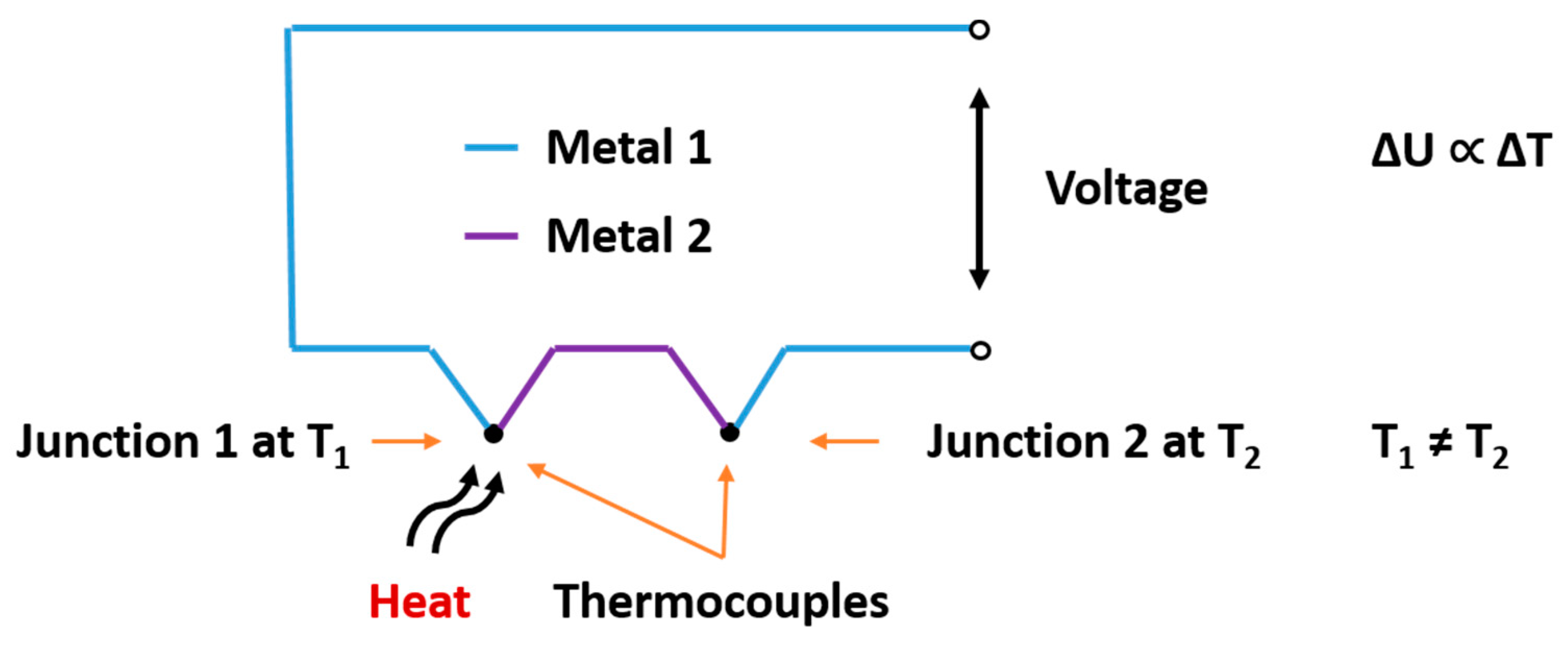
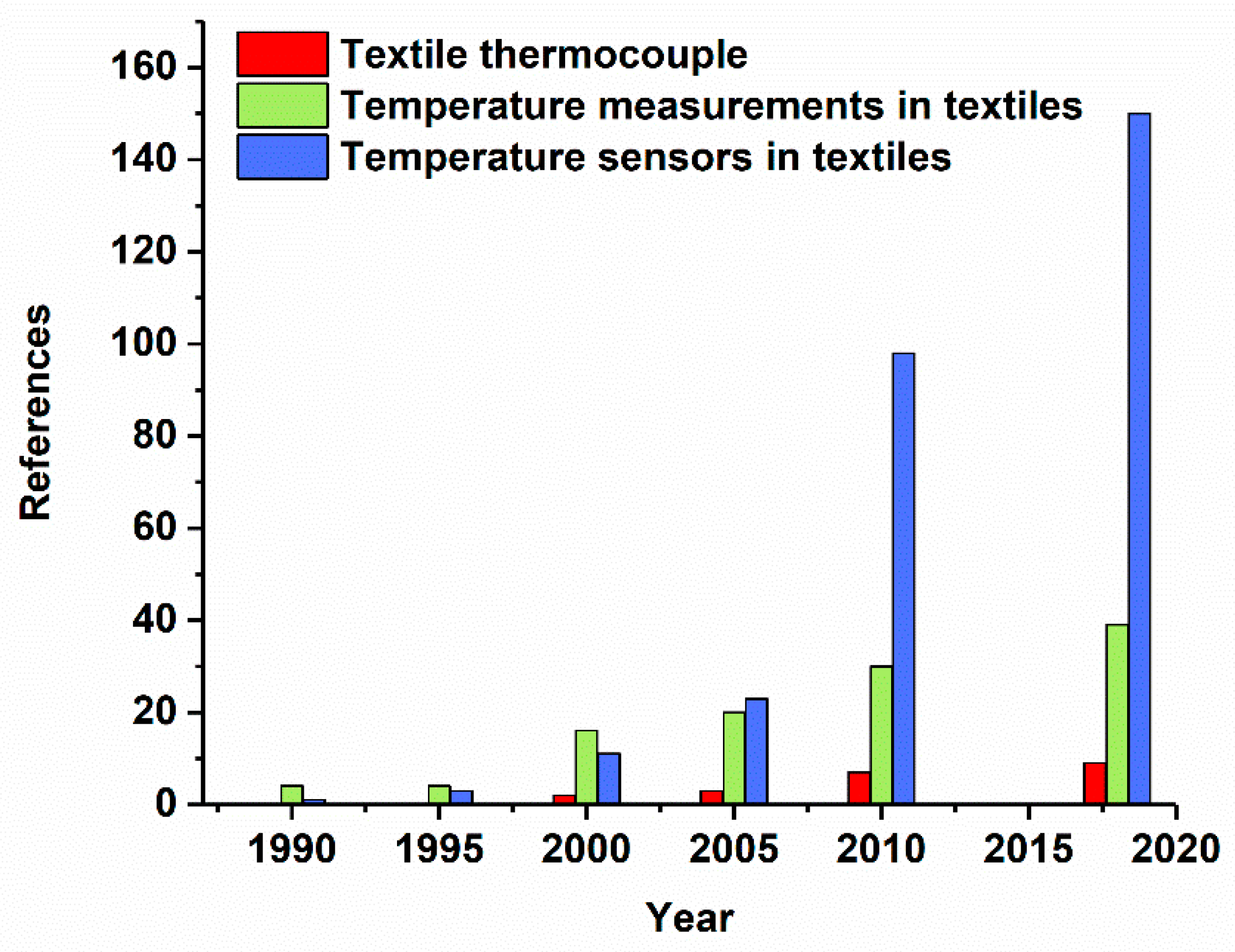
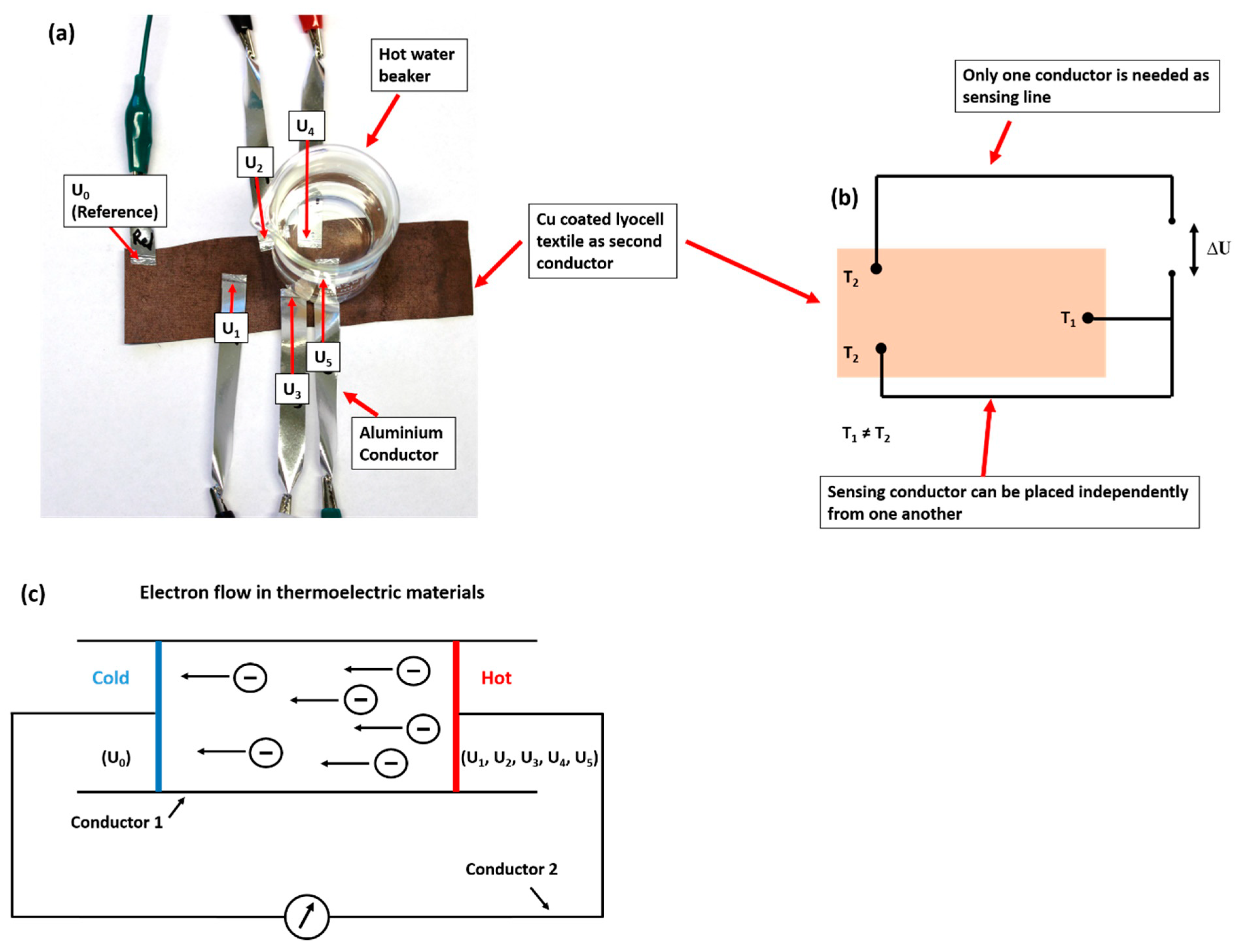
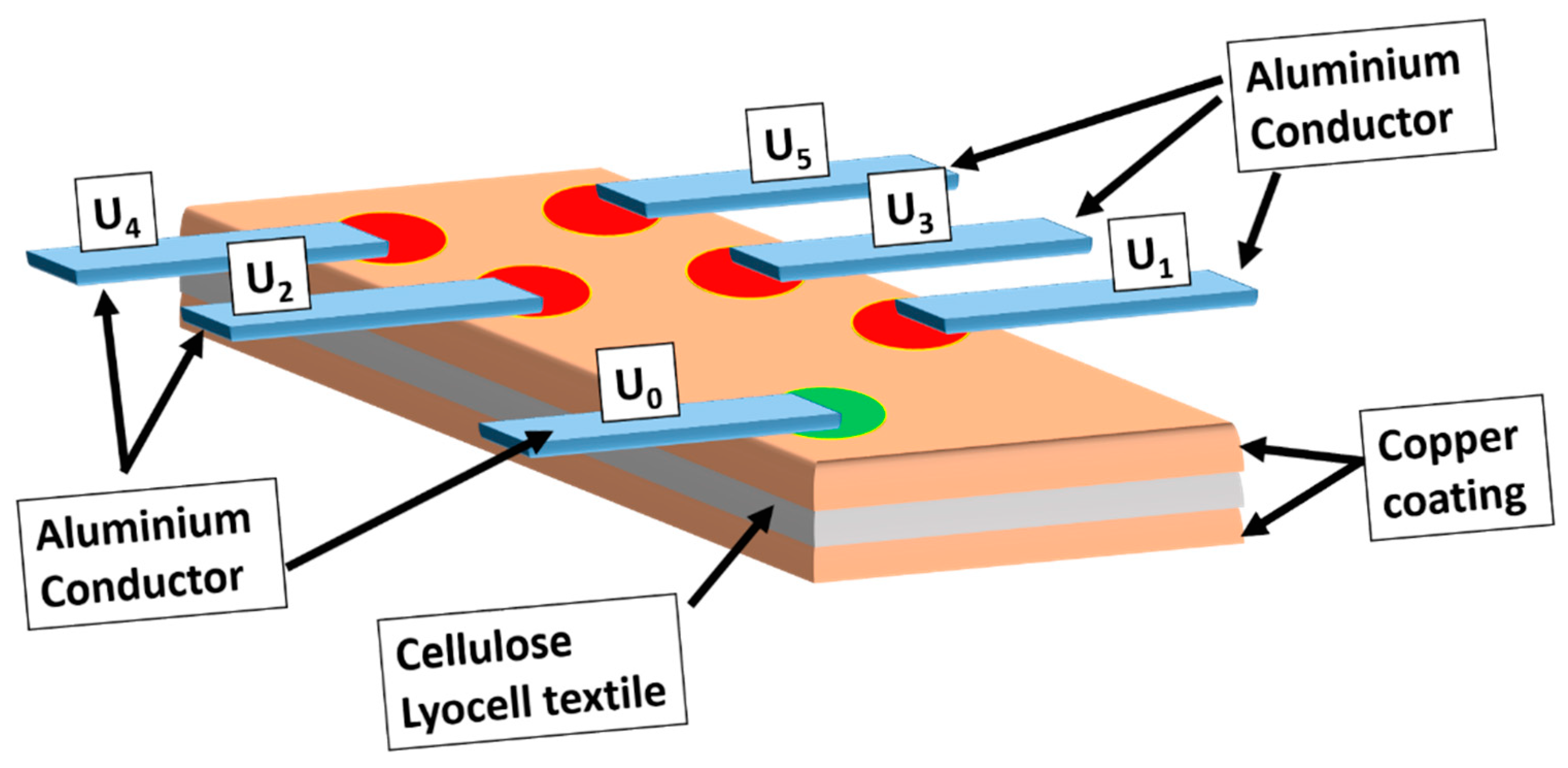
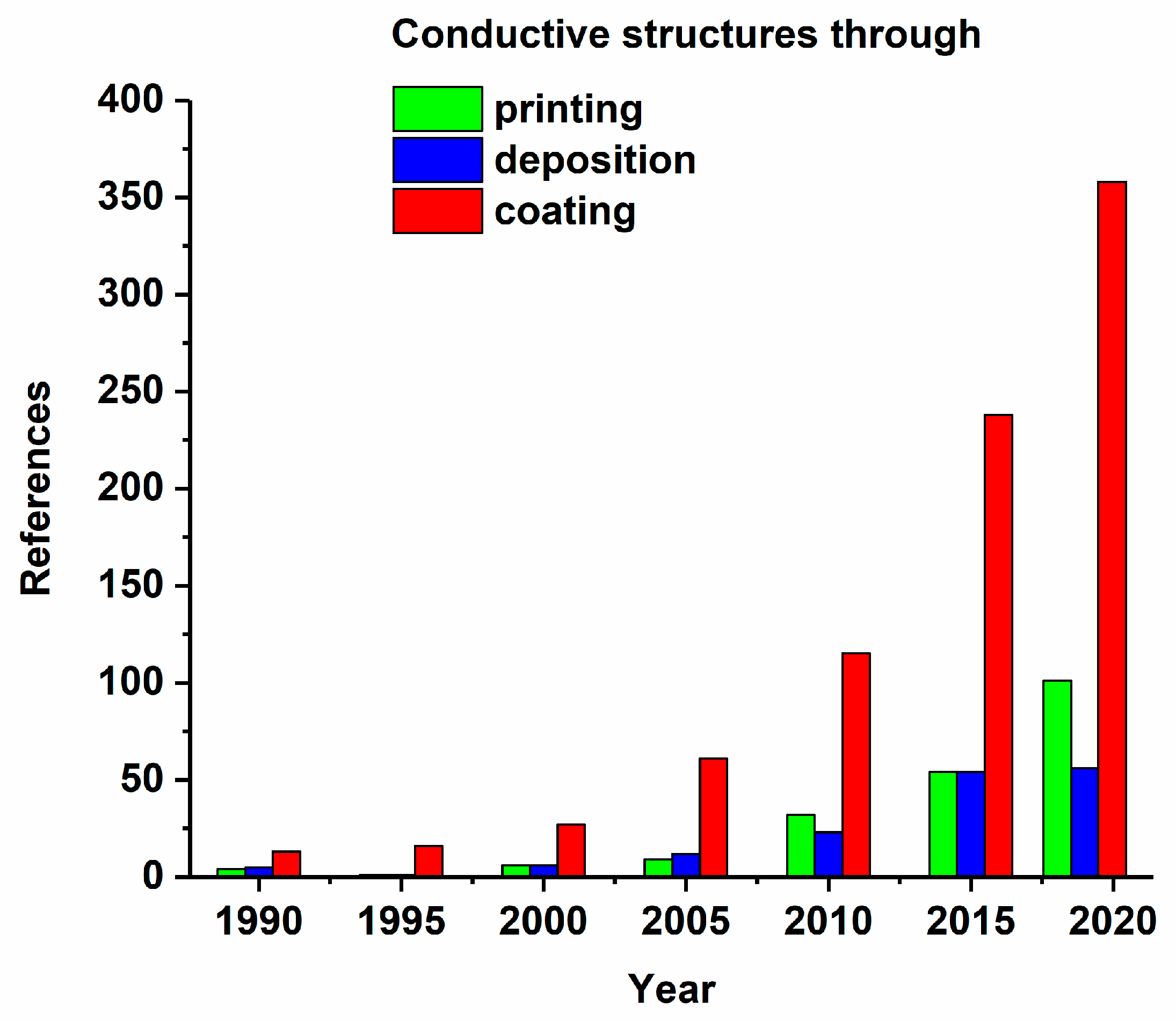


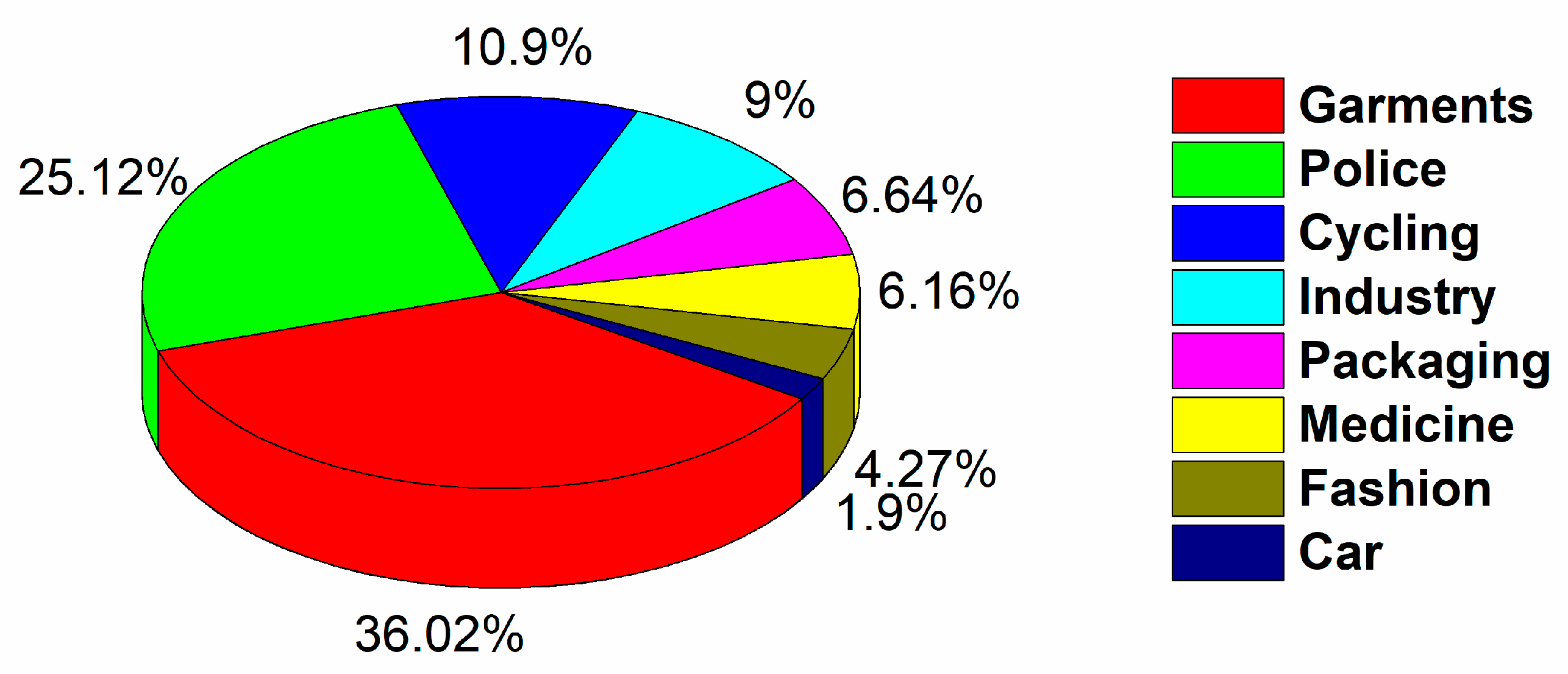
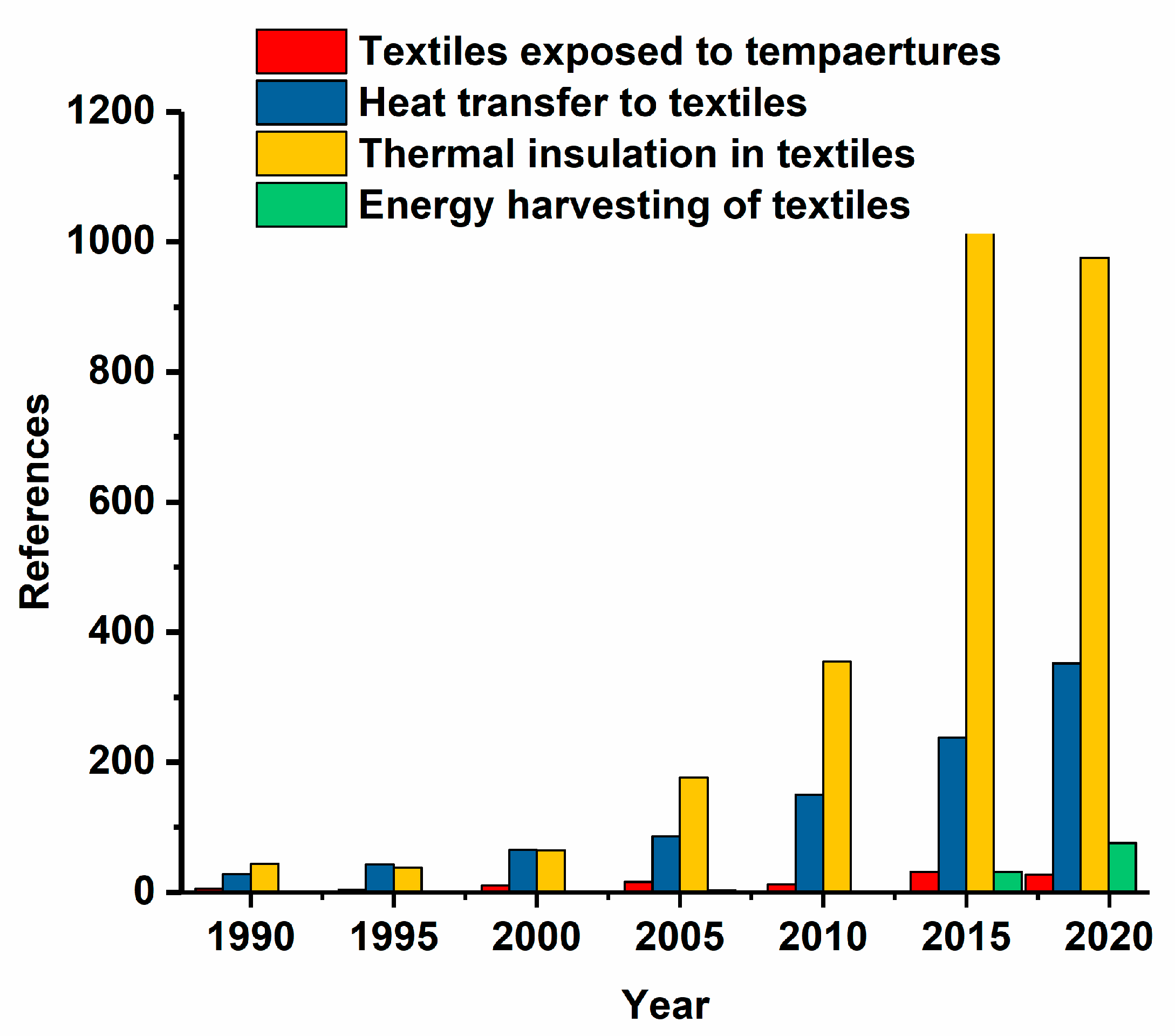
| Materials Used | Technique of Incorporation in Textiles | Reference | Limitations | Advantages |
|---|---|---|---|---|
| Cu, constantan, PES/CO fabric | Weaving | [28] | Conductive | Thermal insulation |
| Cu, constantan | Weaving | [27] | Stiffness | Direct application in T-shirts |
| Polyacrylonitrile thread, steel thread, polyamide thread, polyacrylonitrile yarn, steel fibers, graphite non-woven | Electrical conductive glue | [26] | Stiffness | Direct application in T-shirts |
| Stainless steel and constantan | Embroidery | [9] | Stiffness | Direct application into mattress |
| Poly(3,4-ethylendioxythiophene): poly(4 styrenesulfonate), polyaniline | Screen printing | [23] | Conductive | Sensitivity of 10 µV/K |
| Cu, constantan | Attached on polyester foam | [29] | Stiffness | Adapts to any textile structure |
| Cu-Ni wires, constantan wires | Soldering | [25] | Stiffness | Direct application in fire fighter gloves |
| Measurement Technique | Set Up | Reference | Advantages |
|---|---|---|---|
| PTC | Cr/Au metal electrode structure | [30] | Sensitivity of 1.175 Ω/°C |
| PTC | Au/Cu contacts as flexible thermistor on the Kapton foil | [32] | Elastic conductive paste enhance flexibility |
| PTC | Polyurethane-coated copper filaments used as temperature-sensing textile | [33] | Construction of circuits |
| PTC | Activated carbon fiber cloth used as heating textile clamped between stainless steel electrodes | [31] | Measure temperature up to 200 °C |
| NTC | Two brass blocks placed on conductive fabric | [35] | Fast measurement |
| NTC | Multiwalled carbon nanotube coated poly(methylmethacrylate) yarn placed on metal clamps | [34] | Measure temperature up to 850 °C |
| NTC | Sensor yarns connected to microcontroller | [36] | Fast sensor integration |
| RTD | Conductive metal thread connected to sensor unit | [37] | Detect temperature, relative humidity |
| RTD | Copper electrodes | [38] | Nanocomposites enhance flexibility |
| RTD | Single platinum metal sensor stripes woven into textile | [39] | Fabrication of 120 sensors on one substrate |
| RTD | Platinum wire embedded into polyester fabric as sensing element | [40] | Knitting method similar to standard industrial process |
| RTD | Graphene woven fabrics and polydimethylsiloxane used as temperature sensing unit | [41] | Detect temperature, humidity |
| FBG | Sensors embedded into fabric by cobalt naphthenate and methyl ethyl ketone peroxide resin mixtures | [10] | Temperature sensitivity 150 pm/°C |
| FBG | Cladding-etched fibers used as temperature-sensing substrates | [43] | Glycerin/water compensate Bragg wavelength shift |
| FBG | Flexible optic fiber sensor embedded in sock reflecting the infrared light to the infrared detector | [42] | Measure temperature, pressure, joint angles |
| FBG | Sensors woven into a carbon fiber fabric | [44] | 12 sensors measure temperature on surface and through the thickness |
© 2020 by the authors. Licensee MDPI, Basel, Switzerland. This article is an open access article distributed under the terms and conditions of the Creative Commons Attribution (CC BY) license (http://creativecommons.org/licenses/by/4.0/).
Share and Cite
Root, W.; Bechtold, T.; Pham, T. Textile-Integrated Thermocouples for Temperature Measurement. Materials 2020, 13, 626. https://doi.org/10.3390/ma13030626
Root W, Bechtold T, Pham T. Textile-Integrated Thermocouples for Temperature Measurement. Materials. 2020; 13(3):626. https://doi.org/10.3390/ma13030626
Chicago/Turabian StyleRoot, Waleri, Thomas Bechtold, and Tung Pham. 2020. "Textile-Integrated Thermocouples for Temperature Measurement" Materials 13, no. 3: 626. https://doi.org/10.3390/ma13030626
APA StyleRoot, W., Bechtold, T., & Pham, T. (2020). Textile-Integrated Thermocouples for Temperature Measurement. Materials, 13(3), 626. https://doi.org/10.3390/ma13030626





